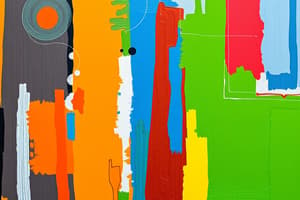Podcast
Questions and Answers
What is the main purpose of line in the elements of art?
What is the main purpose of line in the elements of art?
- To create color variations in artwork
- To enhance the texture of the surface
- To define shape, contours, and suggest mass (correct)
- To represent emotions and feelings
How would you categorize a three-dimensional object in art?
How would you categorize a three-dimensional object in art?
- As a line
- As a texture
- As a form (correct)
- As a shape
What does value in artwork primarily refer to?
What does value in artwork primarily refer to?
- The overall size of the artwork
- The saturation of color in the piece
- The lightness or darkness of a color (correct)
- The type of materials used
Which of the following is NOT a classification of colors?
Which of the following is NOT a classification of colors?
What does texture in art primarily describe?
What does texture in art primarily describe?
Which term describes the two-dimensional measurement of objects in visual arts?
Which term describes the two-dimensional measurement of objects in visual arts?
What is meant by positive space in art?
What is meant by positive space in art?
Which of the following classifications of color includes colors such as green and orange?
Which of the following classifications of color includes colors such as green and orange?
What does the term 'tint' refer to in the context of color in art?
What does the term 'tint' refer to in the context of color in art?
Which element of art specifically relates to the surface character of an artwork?
Which element of art specifically relates to the surface character of an artwork?
Flashcards
Line
Line
A continuous mark used to define shapes, outlines, and suggest mass and volume.
Shape
Shape
A two-dimensional area enclosed by lines.
Value
Value
The lightness or darkness of a color.
Form
Form
Signup and view all the flashcards
Texture
Texture
Signup and view all the flashcards
Color
Color
Signup and view all the flashcards
Study Notes
Elements of Art
-
Line: A mark that defines shape, contours, and outlines, and suggests mass and volume. Created with a pointed tool or implied by the edges of shapes and forms.
-
Shape: An area enclosed by lines. A two-dimensional figure with height and width.
-
Color: The way light is reflected or refracted from a surface; colors we see in nature are reflections of light. Types include primary, secondary, tertiary, complementary, monochromatic, warm, and cool.
Types of Color
-
Primary Colors: Fundamental colors.
-
Secondary Colors: Created by mixing two primary colors.
-
Tertiary Colors: Created by mixing a primary color with an adjacent secondary color.
-
Complementary Colors: Colors opposite each other on the color wheel.
-
Monochromatic: Different shades/values of a single color.
-
Warm Colors: Colors like red, orange, and yellow, associated with warmth.
-
Cool Colors: Colors like blue, green, and violet, associated with coolness.
Space
- Space: The distances or areas around, between, or within components of a piece; arrangement of objects on the picture plane (two-dimensional). Can be positive (occupied space) or negative (surrounding space).
Texture
- Texture: Element appealing to touch: roughness, smoothness, bumpiness, slipperiness. The character of the surface of an artwork.
Value
-
Value: Lightness or darkness of a color. Altered by adding white (tint) or black (shade).
-
Tint: Lightness of a color.
-
Shade: Darkness of a color.
Form
- Form: A three-dimensional object with dimensions of height, width, and length.
Studying That Suits You
Use AI to generate personalized quizzes and flashcards to suit your learning preferences.




